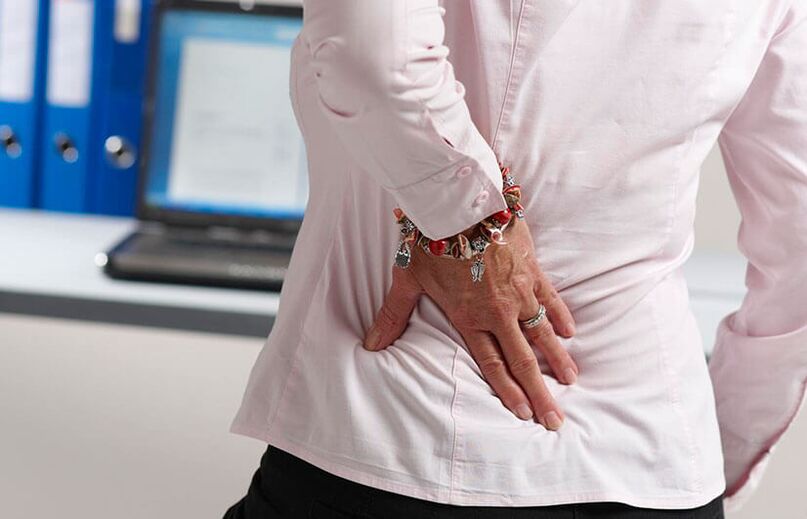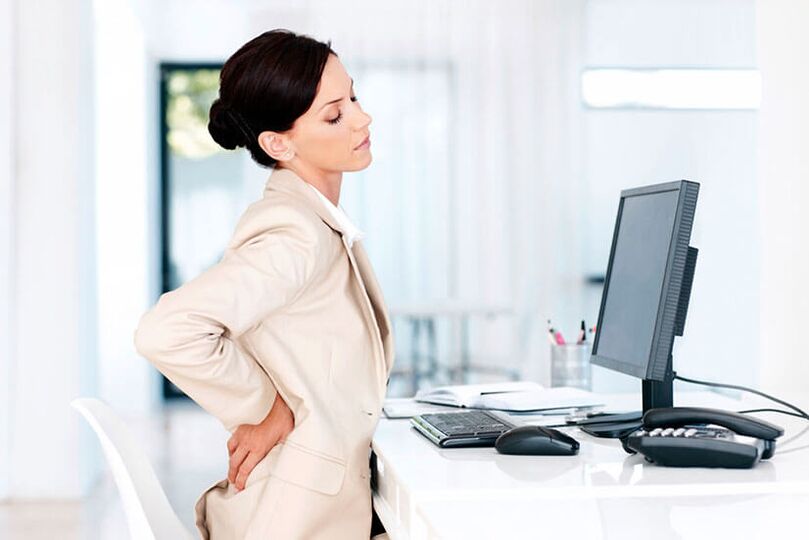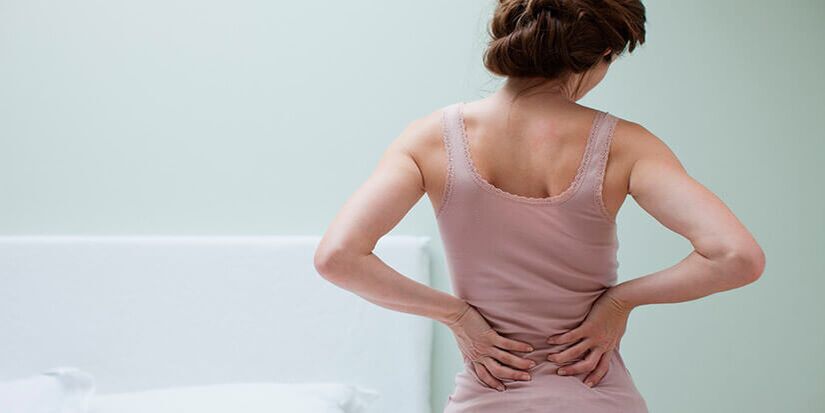Lower back pain is common.Men, women and children suffer from this.The causes of this disease are diverse.

Pain itself is a “bell” that warns of changes in the human body.Pain should not be ignored;it can have serious consequences.You should contact a specialist, identify the cause and start eliminating it.
Causes of lower back pain
The most harmless reason is fatigue.During the day, the spine is under a lot of strain and is not evenly distributed.This leads to an unpleasant, painful feeling in the spine area.Excessive physical activity, heavy lifting.
Of course, various injuries and bruises
The causes can be divided into two main categories – diseases of the spine and internal organs.
Pain occurs, especially in women, as a result of:
- Gynecological diseases (fibroids, vulvitis, adnexitis, tumor of the internal genital organs).
- Pregnancy.Especially in the last trimester, there is a lot of strain on the spine, which leads to lower back pain.This is natural and disappears after birth.
- menstrual cycle.A recoil symptom is certainly possible.
- Abortion.After a stressful state and an inflammatory process.
- climax.Changes in hormone levels lead to circulatory problems in the pelvis.Osteoporosis develops.
For men:
- Features of professional activity.(Lifting weights).
- Prostatitis.Rare, but possible.
- Oncology of the genital organs.After 50 years.
- To do sports.Excessive loads.
For children:
- Wrong posture.This is caused by unsuitable footwear, wearing a backpack incorrectly or bending over textbooks.
- Spinal hernia.
In addition to diseases of the spine, pain is caused by the following pathologies:
- congenital defects of the spine (irregular shape, splitting);
- Appendicitis;
- cholecystitis;
- kidney disease;
- adhesions;
- neoplasms in the back area;
- bone tuberculosis;
- obesity;
- small intestine disease;
- inflammatory processes in the muscles.
What diseases cause lower back pain?

There are both primary and secondary signs of the disease.The primary ones include the diseases of the spine itself. Secondary are pains of a reflective nature, diseases of the internal organs.
Let's look at the most common of them:
- Injuries.Fractures, bruises.Obtained as a result of a fall, impact, accident, sport, etc.
- Scoliosis.Curvature of the spine.Skeletal deformation occurs and a hump is formed.Has an innate or acquired character.
- Osteochondrosis.Joints and bones are destroyed, and nerve fibers are also involved.Can cause radiculitis, hernias and intervertebral discs.
- Osteoporosis.Disorders of calcium and phosphorus metabolism.Bone density decreases and the injury rate increases.
- Rheumatoid arthritis.Chronic inflammatory process in the joints that affects adjacent ligaments and muscles.The development of an autoimmune process is to blame.
- Phlebothrombosis (thrombophlebitis).Complete or partial disruption of blood flow.
- Ankylosing spondylitis.Connective tissue grows and mobility is lost.
- Spondylosis.Natural aging of the joint.
- Lumbago.Destructive changes in the spine are accompanied by acute pain.If left untreated, this leads to irreversible consequences.
- Various kidney diseases lead to lower back pain: pyelonephritis, renal prolapse, renal failure, gout, amyloidosis, diabetic nephropathy, renal colic, etc.
- Types of tumors of the gastric tract and duodenum.
- Pelvic pathologies.
Symptoms and type of pain
The symptoms include varying degrees of discomfort in the lumbar area.Pain in the lumbar region is very diverse.
Divided into periodic and permanent.Periodic diseases are associated with acute pathologies, physical activity and some other individual characteristics of the skeletal structure.
Permanent damage is caused by irreversible damage to the apornomotor system.They cannot be completely cured and come back.
Pain syndrome can also be primary and secondary.The first is directly related to the musculoskeletal system itself, while the second has nothing to do with it and is provoked by the pathologies of other diseases.
Important!The nature of the pain is different: acute, aching, periodic, sharp, pulling, pulsating, aching, mild.In some cases accompanied by numbness in the lower extremities, feeling of cold, reduced sensitivity in the legs, pallor, cramps, lameness, limitation of movement, paralysis.
Diagnostic methods

If the cause of pain is known (trauma, pregnancy, chronic diseases), you should immediately consult a specialist with a more specialized profile.Otherwise, you will need to see a therapist first.
Next, the following procedures are carried out:
- Blood and urine tests, biochemical analysis.
- Ultrasound of the internal organs of the abdominal cavity and heart.
- X-ray of the lumbar spine.
- MRI and CT.The most accurate examination that identifies the cause of the disease.
- Examination of blood vessels.
Based on these results, the cause is determined and appropriate treatment is prescribed.
What to do if your lower back hurts?
First aid

Dull, stabbing or throbbing pain, no matter what kind, makes life very difficult and prevents you from doing the things you are used to and love.
If it was unexpected, the following measures must be taken:
- Lie on a semi-rigid, flat surface so that your spine takes on the correct shape.
- Try to relax.Don't tense your muscles or panic.Self-hypnosis also plays a big role.
- Call a doctor.It is not advisable to take painkillers;The doctor cannot accurately determine the cause of the disease.
- Can be bandaged (fixed).
- Measure the temperature.
During pregnancy:
- exclude physical activity;
- wearing a prenatal bandage;
- perform simple physical exercises while sitting;
- Eat more potassium and phosphorus.
Drug treatment
Tablets:
- Nonsteroidal anti-inflammatory drugs (NSAIDs).Fights inflammation, swelling and improves mobility.
- Chondroprotectors.Prevents the destruction of cartilage tissue and promotes its restoration.
- Muscle relaxants.Relaxes stiff muscles and relieves pain.They are used when NSAIDs have not produced the desired results.
- Corticosteroids.Prevents inflammatory processes and blocks severe pain.
- Narcotic analgesics.Only buy from pharmacies with a doctor's prescription as they are addictive.
- Analgesics.Depending on the severity and type of pain.
- B vitamins.They are used in combination with NSAIDs.Vitamin complexes and vitamins of groups B1, B12, B6.
Ointments, creams:
- Preparations with local irritant and analgesic effects.Reduce discomfort, relax muscles, relieve inflammation, nourish and warm.
- Warming with hot peppers, snake and bee venom.
- Chondroprotective.
Good to know!Medicated patches and injections are also used to treat lower back pain.The latter occurs if all of the above measures did not achieve the desired effect.The injections are carried out directly in the lumbar area.
Folk remedies
Again we turn to traditional medicine.There are many treatment methods among the people, but before using them on yourself, you need to consult a specialist, as there may be contraindications to treatment with these methods.
Let's look at a few examples:
- Fresh or steamed burdock leaves are used as a compress.
- Mustard plasters are combined with honey.
- Mix crushed garlic with vegetable oil.Garlic is also mixed with petroleum jelly and a spoonful of lemon juice.Apply it to the area that bothers you.
- Mix lavender, orange, rosemary, eucalyptus, fir and camphor oils with petroleum jelly.The result is a warming ointment.
- Make a warm compress with mustard powder.Another 200 gr. dry mustard is poured into the bath.After taking it, wrap yourself in a warm blanket.
- Mix a tablespoon of honey and vinegar and put it on a cabbage leaf.Apply to the sore spot and tie with a warm scarf.
- Alcohol tincture of eucalyptus relieves pain.Rub the area that bothers you well.
- Mix sage leaves, birch, pine buds, chamomile, plantain, anise, burdock roots with melted butter or lard.
- Grate and squeeze the beetroot.Mix the cake with a spoonful of kerosene and place it on a napkin or thin cloth.Apply where it bothers you the most.Put polyethylene on top and connect it with something warm.
- Infusions and decoctions of medicinal herbs, fruits and roots for oral administration work wonders.They fight inflammation, supply the body with vitamins and speed up metabolism.Useful plants: chamomile, knotweed, St. John's wort, burdock roots, marigold, violets, dandelions, white willow bark, knotweed, immortelle.
Physiotherapy
Physiotherapeutic procedures can enhance the effect of medications on the body.
Together they produce a wonderful result:
- Paraffin and ozokerite applications.It warms up the affected area perfectly.Apply heated wax layer by layer, up to a height of 1 cm.Then cover with foil and wrap in woolen cloth for an hour.The course lasts 10 to 30 days.
- Electrophoresis.The process is carried out using a special device that provides a weak current signal.A tingling sensation occurs.
- Electrical muscle stimulation.
- Pearl and turpentine baths.
- Mud therapy.Pronounced anti-inflammatory effect and pain reduction.
- Ampipulse therapy.
gymnastics
Gymnastics or physical therapy will help strengthen muscles and heal faster.
Depending on the injury and other indications, an orthopedist or vertebral doctor selects special exercises.
Therapeutic exercises should be performed after the inflammatory process has passed and the pain has subsided.
Constant training strengthens the back muscles and reduces the load on the bones, accelerates blood circulation, which leads to better metabolism in the tissues.
The first courses are carried out under medical supervision, then independently at home.Exercises to arch your back up and down are helpful.And on all fours, bending one way or the other.
A walk and a visit to the pool will be useful.
massage
The benefits of massage are enormous, but if you have lower back pain, it must be performed by an experienced massage therapist.Otherwise, incorrect movements can be harmful and accelerate the progression of pathologies.
Massage movements, if correct, warm up, relieve spasms and activate blood microcirculation.It has a positive effect on the patient's entire body and mood.
The massage uses techniques such as rubbing with the fingertips, stroking and kneading the muscles.
Prevention measures
- Physical exercise is an invaluable aid in prevention.
- You should not make any sudden movements.
- Strengthen your immune system and lead a healthy lifestyle.
- It's worth paying attention to your posture.
- Have an annual check-up with a doctor.
- Proper nutrition and maintaining water balance in the body.
- Avoid stress and nervous shocks.
A notice:It is worth monitoring your health and consulting a doctor for timely treatment.Listen to the alarm signals that the body gives in the form of pain.Do not self-medicate.Because all this can lead to irreversible consequences.



























